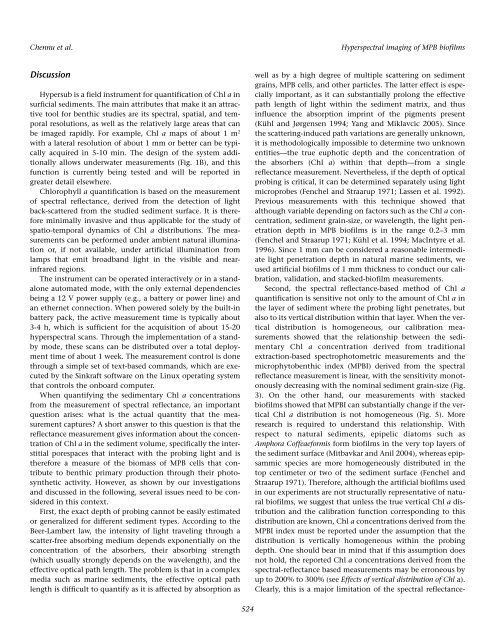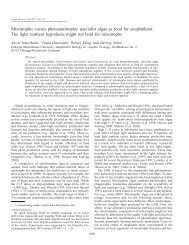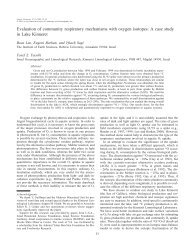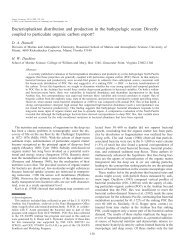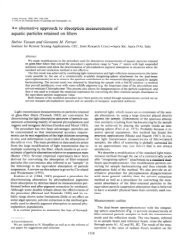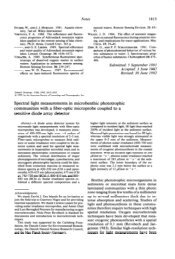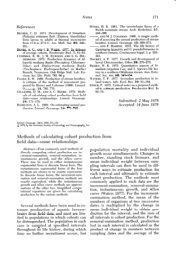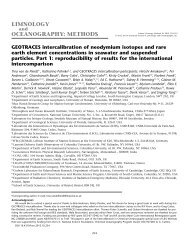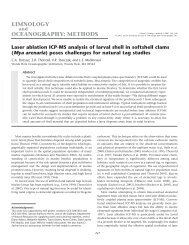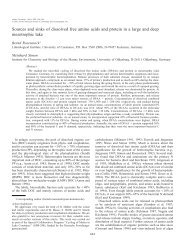Arjun Chennu, Paul Färber, Nils Volkenborn, Mohammad ... - ASLO
Arjun Chennu, Paul Färber, Nils Volkenborn, Mohammad ... - ASLO
Arjun Chennu, Paul Färber, Nils Volkenborn, Mohammad ... - ASLO
Create successful ePaper yourself
Turn your PDF publications into a flip-book with our unique Google optimized e-Paper software.
<strong>Chennu</strong> et al.<br />
Hyperspectral imaging of MPB biofilms<br />
Discussion<br />
Hypersub is a field instrument for quantification of Chl a in<br />
surficial sediments. The main attributes that make it an attractive<br />
tool for benthic studies are its spectral, spatial, and temporal<br />
resolutions, as well as the relatively large areas that can<br />
be imaged rapidly. For example, Chl a maps of about 1 m 2<br />
with a lateral resolution of about 1 mm or better can be typically<br />
acquired in 5-10 min. The design of the system additionally<br />
allows underwater measurements (Fig. 1B), and this<br />
function is currently being tested and will be reported in<br />
greater detail elsewhere.<br />
Chlorophyll a quantification is based on the measurement<br />
of spectral reflectance, derived from the detection of light<br />
back-scattered from the studied sediment surface. It is therefore<br />
minimally invasive and thus applicable for the study of<br />
spatio-temporal dynamics of Chl a distributions. The measurements<br />
can be performed under ambient natural illumination<br />
or, if not available, under artificial illumination from<br />
lamps that emit broadband light in the visible and nearinfrared<br />
regions.<br />
The instrument can be operated interactively or in a standalone<br />
automated mode, with the only external dependencies<br />
being a 12 V power supply (e.g., a battery or power line) and<br />
an ethernet connection. When powered solely by the built-in<br />
battery pack, the active measurement time is typically about<br />
3-4 h, which is sufficient for the acquisition of about 15-20<br />
hyperspectral scans. Through the implementation of a standby<br />
mode, these scans can be distributed over a total deployment<br />
time of about 1 week. The measurement control is done<br />
through a simple set of text-based commands, which are executed<br />
by the Sinkraft software on the Linux operating system<br />
that controls the onboard computer.<br />
When quantifying the sedimentary Chl a concentrations<br />
from the measurement of spectral reflectance, an important<br />
question arises: what is the actual quantity that the measurement<br />
captures? A short answer to this question is that the<br />
reflectance measurement gives information about the concentration<br />
of Chl a in the sediment volume, specifically the interstitial<br />
porespaces that interact with the probing light and is<br />
therefore a measure of the biomass of MPB cells that contribute<br />
to benthic primary production through their photosynthetic<br />
activity. However, as shown by our investigations<br />
and discussed in the following, several issues need to be considered<br />
in this context.<br />
First, the exact depth of probing cannot be easily estimated<br />
or generalized for different sediment types. According to the<br />
Beer-Lambert law, the intensity of light traveling through a<br />
scatter-free absorbing medium depends exponentially on the<br />
concentration of the absorbers, their absorbing strength<br />
(which usually strongly depends on the wavelength), and the<br />
effective optical path length. The problem is that in a complex<br />
media such as marine sediments, the effective optical path<br />
length is difficult to quantify as it is affected by absorption as<br />
well as by a high degree of multiple scattering on sediment<br />
grains, MPB cells, and other particles. The latter effect is especially<br />
important, as it can substantially prolong the effective<br />
path length of light within the sediment matrix, and thus<br />
influence the absorption imprint of the pigments present<br />
(Kühl and Jørgensen 1994; Yang and Miklavcic 2005). Since<br />
the scattering-induced path variations are generally unknown,<br />
it is methodologically impossible to determine two unknown<br />
entities—the true euphotic depth and the concentration of<br />
the absorbers (Chl a) within that depth—from a single<br />
reflectance measurement. Nevertheless, if the depth of optical<br />
probing is critical, it can be determined separately using light<br />
microprobes (Fenchel and Straarup 1971; Lassen et al. 1992).<br />
Previous measurements with this technique showed that<br />
although variable depending on factors such as the Chl a concentration,<br />
sediment grain-size, or wavelength, the light penetration<br />
depth in MPB biofilms is in the range 0.2–3 mm<br />
(Fenchel and Straarup 1971; Kühl et al. 1994; MacIntyre et al.<br />
1996). Since 1 mm can be considered a reasonable intermediate<br />
light penetration depth in natural marine sediments, we<br />
used artificial biofilms of 1 mm thickness to conduct our calibration,<br />
validation, and stacked-biofilm measurements.<br />
Second, the spectral reflectance-based method of Chl a<br />
quantification is sensitive not only to the amount of Chl a in<br />
the layer of sediment where the probing light penetrates, but<br />
also to its vertical distribution within that layer. When the vertical<br />
distribution is homogeneous, our calibration measurements<br />
showed that the relationship between the sedimentary<br />
Chl a concentration derived from traditional<br />
extraction-based spectrophotometric measurements and the<br />
microphytobenthic index (MPBI) derived from the spectral<br />
reflectance measurement is linear, with the sensitivity monotonously<br />
decreasing with the nominal sediment grain-size (Fig.<br />
3). On the other hand, our measurements with stacked<br />
biofilms showed that MPBI can substantially change if the vertical<br />
Chl a distribution is not homogeneous (Fig. 5). More<br />
research is required to understand this relationship. With<br />
respect to natural sediments, epipelic diatoms such as<br />
Amphora Coffeaeformis form biofilms in the very top layers of<br />
the sediment surface (Mitbavkar and Anil 2004), whereas epipsammic<br />
species are more homogeneously distributed in the<br />
top centimeter or two of the sediment surface (Fenchel and<br />
Straarup 1971). Therefore, although the artificial biofilms used<br />
in our experiments are not structurally representative of natural<br />
biofilms, we suggest that unless the true vertical Chl a distribution<br />
and the calibration function corresponding to this<br />
distribution are known, Chl a concentrations derived from the<br />
MPBI index must be reported under the assumption that the<br />
distribution is vertically homogeneous within the probing<br />
depth. One should bear in mind that if this assumption does<br />
not hold, the reported Chl a concentrations derived from the<br />
spectral-reflectance based measurements may be erroneous by<br />
up to 200% to 300% (see Effects of vertical distribution of Chl a).<br />
Clearly, this is a major limitation of the spectral reflectance-<br />
524


